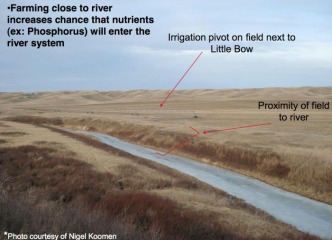Background & Rationale
In 1999, Belsky et al.(1)
completed a comprehensive review of the impacts of livestock grazing on
streams and riparian ecosystems on arid rangelands in the western
United States. Detrimental impacts were found in 80% of streams and
riparian ecosystems and affected a range of stream characteristics
including: water quality and seasonal quantity, stream channel
morphology, riparian zone soils, instream and streambank vegetation,
and aquatic and riparian wildlife.
In the past ten years,
streambank fencing has been recommended by environmental protection
agencies and implemented by land managers as a beneficial management
practice (BMP) to minimize pollution of streams and rivers from
livestock grazing on pastures and rangeland. However, studies on
the effect of exclusion fencing on various riparian health parameters
have yielded conflicting results(2). Many authors have reported
improvements in riparian health parameters following exclusion
fencing(3). Others have documented no recovery of certain
riparian health parameters such as stream morphology following
livestock exclusion(4).
Figure 3. Stream and riparian habitat impacts from cattle use of a watercourse and riparian pasture
Figure 4. Adjacent land uses in addition to cattle ranching with potential to impact stream water quality.
Research Objectives
As water quality
assessment is a common tool used to monitor aquatic health and
environmental risk in streams, rivers and lakes, this research project
aims to examine how water quality alters with the application of a
riparian fencing BMP that excludes cattle stream access.
Cattle
grazing adjacent to streams can contribute contaminants (sediment,
nutrients like nitrogen and phosphorus, and pathogens) directly to the
stream by fecal deposition and indirectly by cattle traffic within the
stream and on streambanks. Removal of cattle disturbance should
therefore result in improvements in water quality parameters:
* reduction in bank disturbance and erosion=> decreased Total Suspended Solids, turbidity
* increase in riparian plant growth and shading of channel=> decrease in water temperature, increase in dissolved oxygen
*
removal of direct faecal deposition => decrease in E.coli, decrease
in nitrogen and phosphorus species, decrease in algal growth.
Expected Results
Possible results include, for each year from 2004 to 2007:
-
finding no significant difference (a=0.05) in annual mean E.coli
concentrations between background water quality levels and levels after
treatment with an 800 m long fenced riparian pasture, or
- finding a
significant difference in annual mean E.coli concentrations between
background water quality and water quality after fencing
treatment.
If a significant difference is found, the
difference may be positive (the fencing treatment improves water
quality by reducing E.coli concentration) or negative (the fencing
treatment reduces water quality by increasing E.coli
concentration). If no significant difference is found in annual
means, then it is possible that there may be a difference in direction
of the effect from week to week - this interaction would confound the
experimental examination of the treatment effect.
Practical
implications of this work include the demonstration of water quality
benefits resulting from BMP implementation that can support ranchers’
selection of BMPs and that can be used in benefit:cost analyses by land
managers funding BMP projects.
Cited references:
(1) Belsky,
A.J., A. Matzke, and S. Uselman. 1999. Survey of livestock influences
on stream and riparian ecosystems in the western United States. J. Soil
and Water Conserv. 54:419-431.
(2)
Sarr, D.A. 2002. Riparian livestock exclosure research in the western
United States: a critique and some recommendations. Environ. Mge. 30:516-526; Agouridis,
C.T., S.R. Workman, R.C. Warner, and G.D. Jennings. 2005. Livestock
grazing management impacts on stream water quality: a review. J. Am.
Water Resour. Assoc. 41:591-606.
(3) Kauffman , J.B., W.C. Krueger, and M. Varva. 1983. Impacts of cattle on streambanks in Northeastern Oregon. J. Range Manage. 36:683-685; Platts,
W.S. and R.L. Nelson. 1985. Stream habitat and fisheries response to
livestock grazing and instream improvement structures, Big Creek, Utah.
J. Soil and Water Conserv. 40:374-379; Trimble, S.W., and Mendel, A.C. 1995. The cow as geomorphic agent-a critical review. Geomorphology 13:233-253; Magilligan,
F.J. and P.F. McDowell. 1997. Stream channel adjustments following
elimination of cattle grazing. J. Amer. Water Resour. Assoc. 33:867-878; Dobkin,
D.S., A.C. Rich, and W.H. Pyle. 1998. Habitat and avifaunal recovery
from livestock grazing in a riparian meadow system of the Northwestern
Great Basin. Conserv. Biol. 12:209-221; Scrimgeour,
G.J. and S. Kendall. 2003. Effects of livestock grazing on benthic
invertebrates from a native grassland ecosystem. Freshwater Biol. 48:347-362.
(4) Kondolf, G.M. 1993. Lag in stream channel adjustment to livestock exclosure, White Mountains, California. Restor. Ecol. 1:226-230; Allen-Diaz,
B., R.D. Jackson, and J. Fehmi. 1998. Detecting channel morphology
change in California’s hardwood rangeland spring ecosystems. J. Range
Manage. 51:514-518; George,
M.R., R.E. Larsen, N.K. McDougald, K.W. Tate, J.D. Gerlach, Jr. and
K.O.Fulgham. 2002. Influence of grazing on channel morphology of
intermittent streams. J.Range Manage. 55:551-557.



